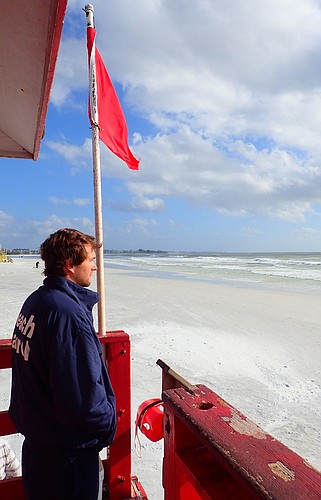- April 24, 2024
-
-
Loading

Loading

Are you dreaming of spending this winter on the beach while your friends up North are blanketed in snow? Think twice before you go into the water.
The weather phenomenon known as El Nino means more than just warmer water and rain for Sarasota County; it also means potentially dangerous surf. The county’s coastline, already pummeled by large storms three times since mid-December, will continue to see them throughout the spring.
During the last week of December, winds in excess of 40 mph near Texas sent 14-foot swell waves — large waves generated by distant weather systems — hurling toward Sarasota County beaches.
County lifeguards on Lido and Siesta beaches reported 28 rescues Dec. 29. Since then, at least two similar events, one Jan. 17 and Jan. 23, have produced unusually large waves and dangerous conditions.
Siesta and Lido beaches have each reported just one rescue during this month through Jan. 25, a reduction that could be the result of Gulf water temperatures dropping into the 50s since December, resulting in fewer swimmers.
National Oceanic and Atmospheric Administration meteorologist Rodney Wynn said El Nino patterns push the Gulf stream farther south, allowing low pressure systems to form. These cause storms and bring wind and rain to develop further south in the Gulf and track northeast, putting Florida’s Gulf coast in a position to receive the brunt of those storms.
Scott Montgomery, Sarasota County lifeguard manager, said lifeguards are highly vigilant during rough weather and take proactive measures to warn swimmers away from dangerous areas. He urged beachgoers to heed lifeguards’ warnings and pay attention to the system of beach flags in place across Florida.
“If we close a beach to swimmers to rough surf,” Montgomery said, “we tell people, ‘Don’t go swimming today. Go do something else; it’s not safe.’”
Montgomery said the preventative approach helps his lifeguards keep people from getting into serious trouble.
Although large waves by themselves can be dangerous, even small waves can cause rip currents, which occur when channels of water sweep away from shore, potentially pulling swimmers into deeper water. Other factors, such as rock jetties or piers, can cause rip currents when currents traveling north or south along the shoreline hit those structures and sweep out to sea.
Lifeguards, visitors and residents alike will have to contend with the effects of El Nino for several months.
Mike Halpert, deputy director of NOAA’s Climate Prediction Center, said El Nino’s effects, which include excessive precipitation and below-average temperatures in our area, have not peaked yet.
The current El Nino, he said, is as strong as the one in 1997, tying for the strongest system on record, since the 1950s.
“The strongest impacts … will happen over the next couple of months,” Halpert said. “We would certainly expect impacts to continue well through the winter and through the early part of the spring.”